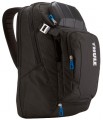—
Chest strap. Attachment in the form of a strap with a clasp that connects the main straps of the backpack at the level of the user's chest. When fastened, such a strap keeps the straps at the same distance from each other and does not allow them to “scatter”. This provides additional convenience in the distribution of weight, as well as a secure fit on the body: it is almost impossible to remove the backpack without unfastening the strap. To adjust to a specific user, the chest strap is often made adjustable.
—
Adjustment of the chest strap. The ability to adjust the height at which the chest strap of the backpack is located. This function allows you to choose the optimal location of the screed, taking into account the height and physique of the user; while the range of adjustment is usually quite extensive. However in some models (especially inexpensive ones), adjustable ties can spontaneously move when accidentally touched, knocking down the height settings; however, this shortcoming is usually not critical.
—
Top straps. Tie-down straps located at the top of the backpack. They are mainly intended for fixing the upper valve, as well as for adjusting the volume of the upper part of the backpack, similarly to the side straps described below (moreover, such adjustment can also be provided in models that do not have a valve).
—
Side straps. Tie straps located on the sides of the backpack — usually one on each side, however, in large tall models, there may be two on the side. The main function of such straps is to “compact” the backpack if it is not completely filled: by tightening the side ties, you can reduce the thickness of the backpack so that the contents are tightly fixed and not dangling inside. In addition, the side tie is convenient to use in combination with the bottle pocket for carrying long items, such as an umbrella or a mat: the lower part of such an item fits into the pocket, and the upper part can be fixed with a tie.
—
Front straps. If the purpose of the ties described above is primarily to adjust the volume, then in the case of front ties they can be described as an additional fastening for placing things. They are two horizontal "belts" at the top and bottom of the backpack, under which you can fasten outerwear (similar to the principle with an elastic cord), a mat or other voluminous things, such as a snowboard. However, for the latter, these ties are not specialized and storage of the board in them is less convenient than in personal mounts. Naturally, the screed also fulfills its main function — it tightens the walls of the backpack, making its shape more “slender” and compact.
—
Bottom straps. Tie-down straps located on the underside of the product. They allow you to adjust the volume of the lower part of the backpack (or the lower pocket), provide additional support and fixation of the contents, and in some models they can also be used as a fastener for carrying various items “on an external sling”: for example, you can put ties into stretched to the maximum size karemat and tighten the straps, securely securing the outer load.
—
Waist belt. An additional device in the form of a belt, which, when fastened, covers the user's body in the area of the belt. The specific design of this part may vary. So, in relatively small backpacks, it is just a strap made of nylon or other similar material, and in large volumetric models, two wide and thick “petals” are provided that are adjacent to the user’s sides and are interconnected by a small strap with a clasp. Anyway, the main function of the waist belt is to redistribute the load: it allows you to transfer the load from the shoulders to the pelvic area, which is especially convenient when carrying heavy loads. In addition, such a device provides additional reliability of fixing the backpack on the body.
The maximum diagonal of a laptop that can fit in the corresponding compartment of the backpack. Note that the average (standard) diagonal for modern laptops is 15.6", and most backpacks have
a 15" laptop compartment. However, there are also more voluminous models that can accommodate a
17.3" or even 18.4" laptop. At the same time, compact models are also presented: there are
backpacks with a compartment for a laptop 14",
13" and even smaller.
Note that the
lack of a laptop compartment in itself does not prevent using a backpack to carry a laptop, however, in this case, the maximum allowable size of the device will have to be specified according to the dimensions of the backpack.

